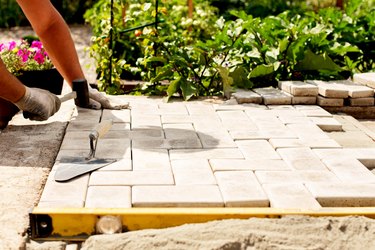
Sand is a necessary component to properly building a patio with paver stones that will remain attractive for years to come. When compacted, sand provides a stable surface that allows pavers to sit level and uniform. After installation, excess sand is swept into the joints between pavers, locking them into place. The type of sand used for installing pavers is critical for keeping maintenance on your patio to a minimum. Forgo play sand, which is too fine and rounded for hardscaping purposes. Stone dust and masonry sand are also too fine to provide a stable base. Here are a few types of sand that will support a long-lasting and beautiful patio.
Best Sand Base for Pavers
Video of the Day
Coarse sands that incorporate some stone should be used underneath pavers to provide the most durable base for your patio. The variable grain shape and size allow the sand to firm up when compacted. While any coarse sand can serve the purpose, anyone who has walked on a beach knows that sand tends to shift under weight. A better option is concrete sand, a crushed stone product found at your local rock yard or landscape supply company that is often used in walkways. At the hardware store, you can use any sand marketed as paver base or paver leveling sand, which is typically made of a mix of crushed stone and sand. Paver sands can be found in varying shades of browns, tans, and grays.
Video of the Day
For the firmest base, lay the sand on top of 4 to 6 inches of compacted 1/2- to 3/4-inch gravel from a landscape supplier. The sand layer should be 1 to 1 1/2 inches thick. Moisten the sand with water from a hose to help with compaction and use a long piece of 2x4 lumber to smooth and level the sand. Now you are ready to install your pavers.
Best Sand for Joints in a Patio
After installation, sand is used in the joints between pavers to lock them in place. You can sweep any coarse sand into the cracks, but for the greatest durability, use polymeric sand. Polymeric sand is coated with a water-activated polymer that binds when exposed to water. This creates a strong joint that suppresses weeds and deters insects. Much like a grout, polymeric sand comes in different colors to complement your pavers. Polymeric sand does not allow much water penetration, however, so this product is best used in an area that doesn't have issues with drainage.